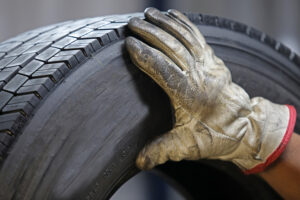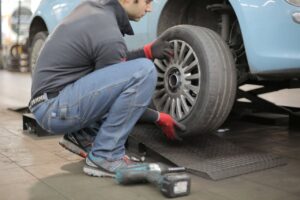How Do Different Tyre Tread Patterns Work?
All motorists have noticed the patterns on every single tyre on the road, but what do they actually do? Tread patterns are much more than just a decorative print, and are actually a significant contributor to your vehicle’s performance. There are many different tread patterns each made to handle different terrains, driving conditions, and weather types, along with contributing to grip, handling and vehicle control. The main types of tread patterns include: symmetrical, asymmetrical and directional, so let’s go through the difference.
Symmetrical
Symmetrical tyre treads are the most commonly used and are a single pattern which spans the whole of the tyre’s surface. Symmetrical tyre treads are frequently used due to their reduced noise and overall durability. For most passenger cars, tyres with a symmetrical tread pattern offer a smooth driving experience, better longevity, increased fuel efficiency and a great level of control in moderate driving conditions.
These tyres can also be rotated in a number of ways, increasing their versatility and reducing wear in certain pressure points, meaning you’ll get the most out of your tyres.
Asymmetrical
Asymmetrical tyre treads are more unique in their pattern. They feature different patterns from the inside to the outside edge of the tyre. This mixture of patterns helps the tyre deliver maximum levels of grip in both wet and dry weather. The inside, more detailed pattern, is designed for wet weather driving and the outer pattern is most beneficial to dry roads with the larger tread blocks.
This unique tread pattern is usually found on high performance sports vehicles. The inner pattern works to disperse water and reduce aquaplaning whilst the outer tread ensures noise levels are low and grip is high, making them the perfect tyres for a demanding driver.
Directional
Directional tyre treads offer inward/arrow-like grooves which work to disperse water from the tyre’s surface most effectively. This type of tyre tread is perfect for offering maximum safety in wet weather conditions, along with ice, snow and even off-road terrains. For optimum control and safety in colder climates and during winter months, tyres with a directional tread pattern will offer the most peace of mind. This tread is often found on many winter tyres and even some all-season tyres.
What about the rest of it?
There is a lot more to a tyre’s tread than the pattern itself. Smaller details on the tyre’s surface complete the tyre’s tread for optimum performance. We’ll break it down for you here:
- Grooves: The large indentation channels which make the most prominent pattern. In wet driving conditions, water passes through these channels to minimise aquaplaning by reducing the surface’s contact with the water.
- Ribs: The raised parts of the tyre (essentially the opposite of grooves). Ribs are the parts of the tyre that make contact with the road’s surface.
- Sipes: The smaller indentations that cover the whole of the tyre’s surface. These work just like the large grooves by helping to eliminate water. They also work to enhance the tyre’s grip on the road.
- Blocks: The raised sections of the tread where ribs are grouped together.
When all of these elements are put together, they make up the tyre’s tread pattern. The variety and versatility of all these elements allow tyre manufacturers like Bridgestone, Goodyear and Continental to produce a wide variety of new tyres which offer different benefits to drivers. If you need new tyres, we stock leading brands right here at etyres.
Remember, it is important to ensure that all four tyres on your vehicle offer the same tread, whether this is symmetrical, asymmetrical or directional. Mixing treads will hinder your safety on the roads and compromise your vehicle’s performance.




